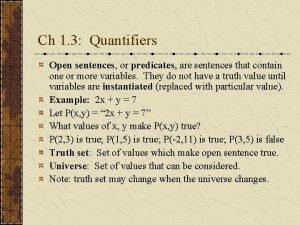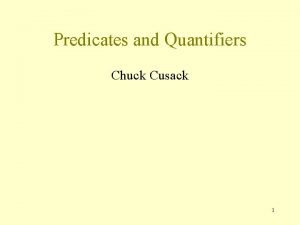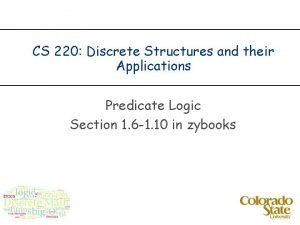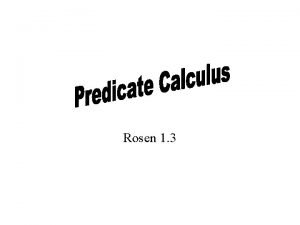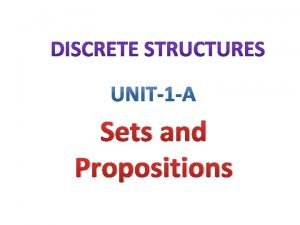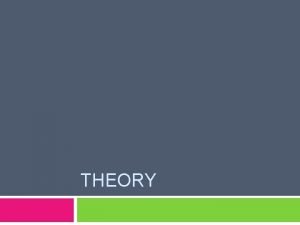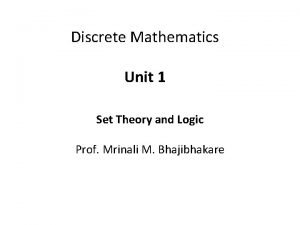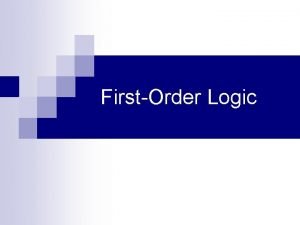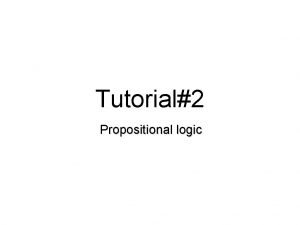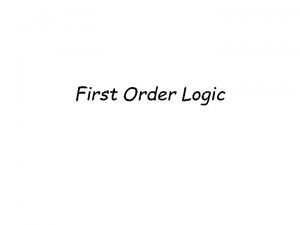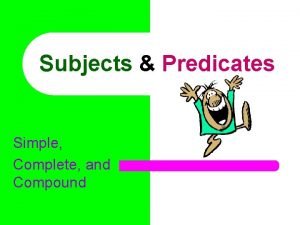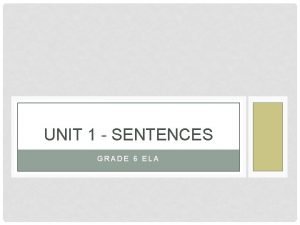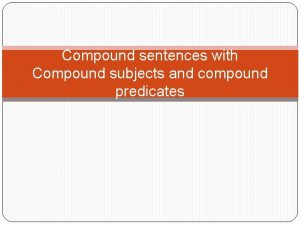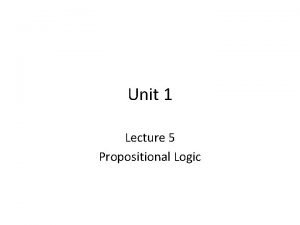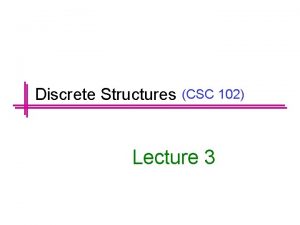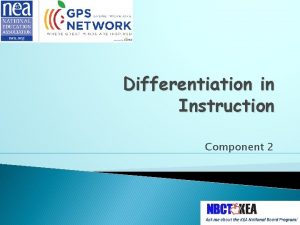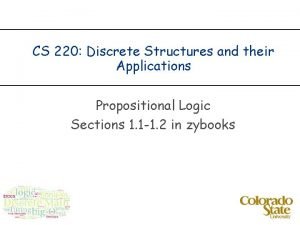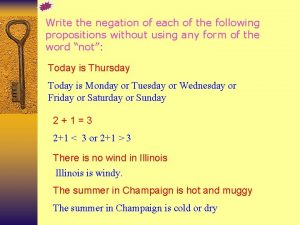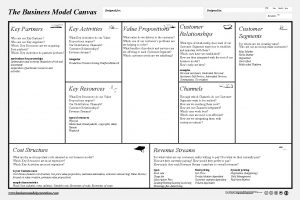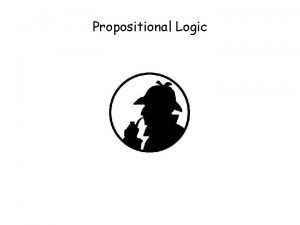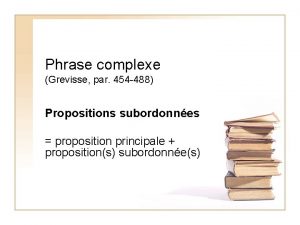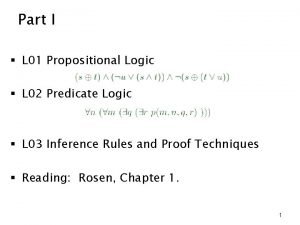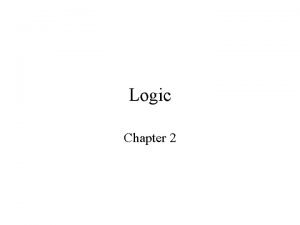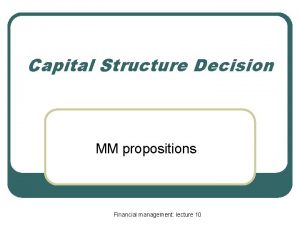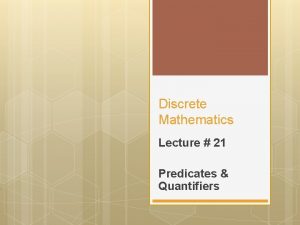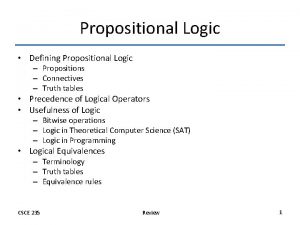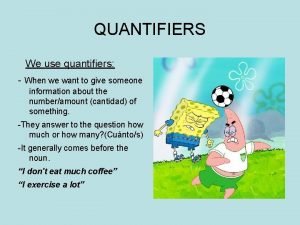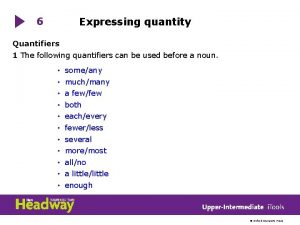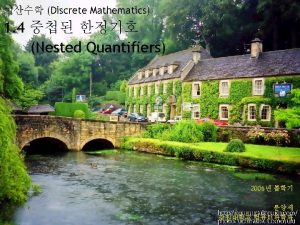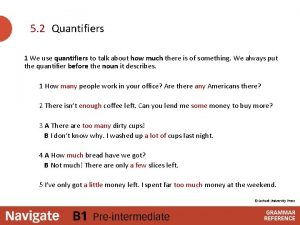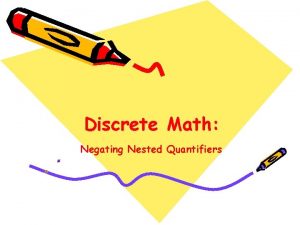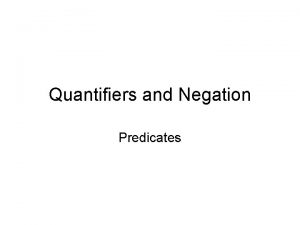Predicates and Quantifiers Predicates aka propositional functions Propositions






![Some Examples • [P(x: integer) : boolean -> x > 3] • [Q(x: integer, Some Examples • [P(x: integer) : boolean -> x > 3] • [Q(x: integer,](https://slidetodoc.com/presentation_image_h/084868b48ba77613c0f0fc8f34e000e0/image-7.jpg)






























- Slides: 37

Predicates and Quantifiers

Predicates (aka propositional functions) Propositions (things that are true or false) that contain variables P(-2) is false P(42) is true P(0) is false … • predicates become propositions (true or false) if • variables are bound with values from domain of discourse U • variables are quantified (more in a minute) The above predicate, we need to state what values x can take, i. e. what is its domain of discourse? Let U = Z, the set of integers {…, -2, -1, 0, 1, 2, …}

Predicates (aka propositional functions) Let U = Z, the set of integers {…, -2, -1, 0, 1, 2, …} Not a proposition. Variable y is unbound

Predicates (aka propositional functions) Let U = Z, the set of integers {…, -2, -1, 0, 1, 2, …} Put another way: “Let the domain of discourse be the set of all integers” What is: • R(2, -1, 3) ? • R(x, 3, z) ? • R(3, 6, 9) ?

What is a predicate/propositional function? • A boolean function, i. e. delivers as a result true or false • is. Odd(x), is. Even(x), is. Married(x), is. Woman(x) … • is. Greater. Than(x, y) • sums. To. One. Hundred(a, b, c, d, e) • In Claire (a nice language) • [P(x: integer) : boolean -> x > 3] • In Claire (a nice language) • [R(x: integer, y: integer, z: integer) : boolean -> x + y = z] • is. Going. Mad(x) • has. ALife(x) • odd. P(x)

![Some Examples Px integer boolean x 3 Qx integer Some Examples • [P(x: integer) : boolean -> x > 3] • [Q(x: integer,](https://slidetodoc.com/presentation_image_h/084868b48ba77613c0f0fc8f34e000e0/image-7.jpg)
Some Examples • [P(x: integer) : boolean -> x > 3] • [Q(x: integer, y: integer) : boolean -> x + y = 0] • [R(x: integer, y: integer, z: integer) : boolean -> x + y = z] • For P, Q, and R universe of discourse (domain) is set of integers

Some Examples

Quantifiers (universal) The universal quantifier asserts that a property holds for all values of a variable in a given domain of discourse “for all” “for all x P(x) holds” But what’s the domain of discourse? We must state this! Could also do this For all integers, P(x) holds





Quantifiers (universal) Same thing! AND

Quantifiers (existential) The existential quantifier asserts that a property holds for some values of a variable in a given domain of discourse “there exists” “there exists a value of x such that P(x) holds” But what’s the domain of discourse? We must state this! Could also do this There is an integer value of x such that P(x) holds

Quantifiers (existential) Same thing! OR

Quantifiers Let the universe of discourse U be the set of real numbers True or false? So, we can nest quantifiers: example overleaf

Quantifiers Let the universe of discourse U be the set of integers Nesting: what do these mean?

Quantifiers Nesting: what do these mean?

Quantifiers Nesting: what do these mean?

Quantifiers Nesting: what do these mean?

Quantifiers Nesting: what do these mean?

Quantifiers and negation

Some Examples • public static boolean P(int x){return x > 3; } • public static boolean Q(int x, int y){return x + y == 0; } • public static boolean R(int x, int y, int z){return x + y = z; } • For P, Q, R universe of discourse (domain) is set of integers This is false There is no single value of y for this Yip! Y will equal x! NOTE: sensitivity of order of quantification

Forgive me for misusing java conventions

Beware! That’s okay ! a m r a Bad K

NOTE!

Examples • P(x): x is a lion • Q(x): x is fierce • R(x): x drinks coffee • Universe of discourse • all creatures, great and small All lions are fierce Some lions don’t drink coffee Some fierce creatures do not drink coffee

Even more examples Everyone has a best friend • B(x, y): x’s best friend is y • Universe of discourse • people Yikes!

When will these examples stop? ! If somebody is a female and she’s a parent then she is someone’s mother • F(x): x is a female • P(x): x is a parent • M(x, y): x is the mother of y • Universe of discourse • people

Can I think of this stuff in some concrete way? Okay : = true for x in U while okay do for y in U while okay do okay : = P(x, y) okay

Can I think of this stuff in some concrete way? Okay : = true for x in U while okay do begin okay : = false for y in U while not(okay) do okay : = P(x, y) end okay

Can I think of this stuff in some concrete way? Okay : = false for x in U while not(okay) do begin okay : = true for y in U while okay do okay : = P(x, y) end okay

Can I think of this stuff in some concrete way? Okay : = false for x in U while not(okay) do for y in U while not(okay) do okay : = P(x, y) okay

Non-trivial example: arc-consistency “For any pair of variables (i, j), for all values in the domain of variable i there will exist at least one value in the domain of variable j such that we can instantiate variable i to the value x and variable j to the value y and it will be consistent” Is this an arc-consistent state?

An min ultrametric tree and its min ultrametric matrix Matrix value is the value of the most recent common ancestor of two leaf nodes 3 5 4 8 A D B E As we go down a branch values on interior nodes increase Matrix is symmetric C

ultrametric 3 5 4 8 A D E B C
 Open propositions and quantifiers
Open propositions and quantifiers Quantifiers
Quantifiers Applications of predicates and quantifiers
Applications of predicates and quantifiers Propositional function examples
Propositional function examples Mapping between facts and representation
Mapping between facts and representation Sets and propositions in discrete mathematics
Sets and propositions in discrete mathematics Examples of reciprocal determinism
Examples of reciprocal determinism Discrete math set theory
Discrete math set theory Propositions and arguments
Propositions and arguments Pros and cons of propositional logic
Pros and cons of propositional logic Logic translation symbols
Logic translation symbols Translation by a more general word examples
Translation by a more general word examples Propositional logic examples and solutions
Propositional logic examples and solutions Biconditional proposition examples
Biconditional proposition examples Simple and complete subjects and predicates
Simple and complete subjects and predicates Compound subjects
Compound subjects Unit 1 subjects predicates and sentences
Unit 1 subjects predicates and sentences Complete compound subject
Complete compound subject Simple proposition
Simple proposition Rogerian psychotherapy
Rogerian psychotherapy The components of categorical propositions
The components of categorical propositions Fuzzy propositions examples
Fuzzy propositions examples Conditional proposition example
Conditional proposition example 5 core propositions
5 core propositions Compound proposition truth table
Compound proposition truth table Behavioral segmentation divides consumers according to
Behavioral segmentation divides consumers according to La proposition conditionnelle
La proposition conditionnelle What is the negation of each of these propositions
What is the negation of each of these propositions Which key resources are we acquiring from partners
Which key resources are we acquiring from partners Code of the street
Code of the street Logic equivalence
Logic equivalence Les propositions
Les propositions Logical equivalence
Logical equivalence Propositions in logic
Propositions in logic Subordonnée de cause
Subordonnée de cause Single minded proposition examples
Single minded proposition examples M&m propositions
M&m propositions Partner business propositions
Partner business propositions
